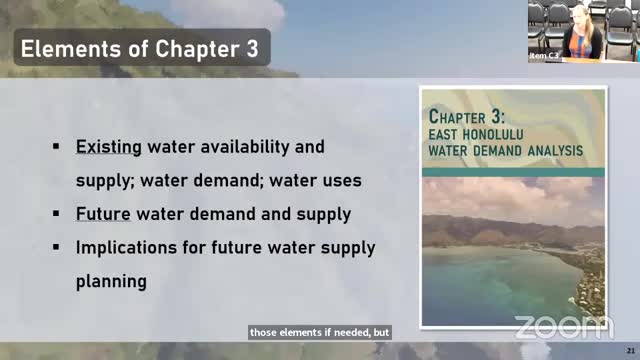Water Crisis Looms as Demand Surges in Honolulu District
November 19, 2024 | Water Resource Management, Commission on, Executive , Hawaii
This article was created by AI summarizing key points discussed. AI makes mistakes, so for full details and context, please refer to the video of the full meeting. Please report any errors so we can fix them. Report an error »

In a recent government meeting, officials discussed critical water resource management strategies for the district, focusing on the characterization of water supply and demand, as well as the identification of primary water users. The meeting highlighted the sustainable yields of the district's aquifers, with Wailea East providing 2 million gallons per day and Wailea West contributing 2.5 million gallons, totaling a sustainable yield of 4.5 million gallons daily.
The analysis revealed that per capita water usage in East Honolulu remains above the island average, with figures from 2010 indicating a daily consumption of 194 gallons per person—25% higher than the average. Although this figure has decreased in recent years, it remains elevated due to factors such as larger properties and extensive landscaping.
The district primarily relies on water transfers from the primary urban center and Windward areas, underscoring the need for local conservation efforts. Future water demand was assessed through three scenarios—low, mid, and high—alongside projections for 2100 that consider climate change impacts, including varying rainfall scenarios. The analysis indicated that under the most probable low demand scenario, current water supplies are adequate. However, mid and high demand scenarios would necessitate additional resources or improved efficiency.
The meeting also addressed potential future challenges, noting that a dry rainfall scenario could lead to increased irrigation demands, while a wet scenario might ensure adequate supply. Officials emphasized the importance of efficient water use and the potential vulnerabilities of water transfers, particularly in light of drought and contamination risks. The discussion concluded with a call for responsible water management practices to safeguard resources for future generations.
The analysis revealed that per capita water usage in East Honolulu remains above the island average, with figures from 2010 indicating a daily consumption of 194 gallons per person—25% higher than the average. Although this figure has decreased in recent years, it remains elevated due to factors such as larger properties and extensive landscaping.
The district primarily relies on water transfers from the primary urban center and Windward areas, underscoring the need for local conservation efforts. Future water demand was assessed through three scenarios—low, mid, and high—alongside projections for 2100 that consider climate change impacts, including varying rainfall scenarios. The analysis indicated that under the most probable low demand scenario, current water supplies are adequate. However, mid and high demand scenarios would necessitate additional resources or improved efficiency.
The meeting also addressed potential future challenges, noting that a dry rainfall scenario could lead to increased irrigation demands, while a wet scenario might ensure adequate supply. Officials emphasized the importance of efficient water use and the potential vulnerabilities of water transfers, particularly in light of drought and contamination risks. The discussion concluded with a call for responsible water management practices to safeguard resources for future generations.
View full meeting
This article is based on a recent meeting—watch the full video and explore the complete transcript for deeper insights into the discussion.
View full meeting
